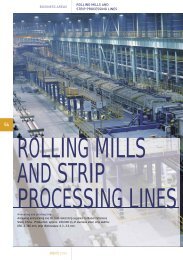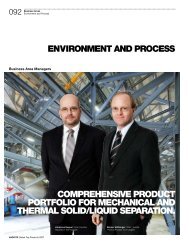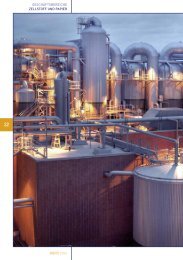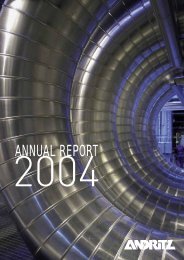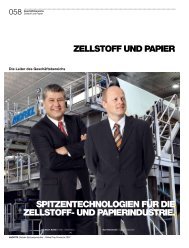download - andritz business areas
download - andritz business areas
download - andritz business areas
- No tags were found...
Create successful ePaper yourself
Turn your PDF publications into a flip-book with our unique Google optimized e-Paper software.
054Business AreasPulp and PaperResearchand DevelopmentThe Divisions have focused their R&D programs primarilyon improving fiber quality while lowering investment, operatingand maintenance costs, and also reducing environmentalimpact of the equipment and processes.The trend today is towards large, single-line mills, sinceredundant or repetitive smaller systems increase bothcapital and operating costs. This places extreme demandson the equipment in terms of scale, reliability, andavailability. All Andritz Divisions are actively developinglarger scale equipment.The Divisions’ R&D programsin detail are as follows:Wood ProcessingThe main focus was on large-scale field-testing new developmentsat customer locations. The new chip samplingsystem was started up and automatically producedrepresentative chip samples for the analyzer. This provideschip quality information for use by pulp mill operators.Full-scale tests of debarking behavior of tropical hardwoodswere carried out in southern Europe. The testsgenerated important information about the correct debarkingparameters. Tests of a new method for removingloose bark from hardwoods were successful. In NorthAmerica, a new monitoring and diagnostics package forportal cranes, which will improve the overall efficiency ofthe equipment, was developed.FiberlineDevelopments are continuing in the program to reducecustomers’ overall costs while maintaining equipmentperformance and availability. The adaptation and improvementof process and equipment solutions forsouthern hemisphere applications are also progressing.These developments are not only related to scale-up ofthe production capacity for extremely large mills, butalso to the development of cost-competitive solutionsfor small and medium-size mills.New developments of the Drum Displacer (DD)Washer show remarkable progress with regard to washingefficiency and capacity. The best proof for these improvementsis visible in the start-up curves and chemicalconsumption figures of recent deliveries. The next generationof MC equipment is under intensive developmentwith the goal of system simplification and energysavings.In the area of modeling and simulation development,the first Advanced Control Systems (ACS) were sold toVCP in Brazil and CMPC in Chile to optimize the digesteroperations. Development work continues to include theremaining fiberline process <strong>areas</strong>.RecoveryFurther development of black liquor crystallizing technologyis underway to extend the time between concentratorwashouts and to improve evaporator availability.The first Ash Re-Crystallization (ARC) system for chlorideand potassium removal was successfully commissionedat the Portucel Soporcel Group mill in Portugal. Duringthe start-up, a new computer model for simulating theARC process and leaching processes was tested.Research has been conducted on evaporator materials.Electro-chemical testing of the corrosion resistance ofdifferent materials has been performed in a mill environment.In addition, through heat transfer material research,the Division has found more cost-effective materials forevaporators. Development of manufacturing and weldingprocedures for lamellas is an important part of theresearch. The study is being conducted in cooperationwith technical universities and material producers.Developments for recovery boilers are focused onproducing more power from biofuel (black liquor), whichalso eliminates the release of greenhouse gases intothe atmosphere. A new arrangement of heat transfersurfaces in the upper furnace of the recovery boiler isimplemented in three new recovery boilers now underconstruction. This will enable more effective utilizationof flue gas heat to produce higher pressure steam inthe boiler.Chemical SystemsA new lime kiln burner has been developed, and is nowsuccessfully operating at a mill in Finland. The burnerproduces lower nitrogen oxide levels than existing technology.A centrifuge for green liquor dregs handling is beingmarketed. It offers advantages for mills which carefullymanage non-process element removal in the lime circulation.A new concept for lime mud drying has been developedand a patent has been applied for. The new technologyshould enable customers to increase the capacity of existingkilns with lime mud dryers or reduce the size of anew lime kiln for a given capacity.The first LMD-Filter TM for lime mud dewatering and washinghas exceeded performance expectations. Two unitsare in operation and seven units were sold. Developmentsare continuing to design larger sizes of all majorequipment in the white liquor plant (4,000 t/d pulp productionand 14,000 m 3 /d white liquor production).Pulp Mill ServicesLife cycle management and optimization have been theDivision’s focus <strong>areas</strong> during the last few years.For the woodyard, a service has been developed to optimizechipping operations efficiency and control. The offeringis a combination of equipment (HQ-Plus chipperknife system), service, and automation (Acutest ® conditionmonitoring and the new chip sampler/analyzer).In the chemical recovery area, cast air nozzles, minihoods,and smelt shattering systems in the recoveryboiler improve equipment availability and extend thetime between shutdowns.A new product group, Automation & Diagnostics, isresponsible for developing and managing automationtechnology – including condition monitoring, simulation,process control, and optimization.ANDRITZ Annual Report 2005



